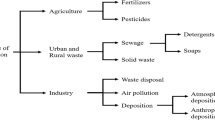Abstract
This study was designed to test the capability of electrokinetic technology to remediate the soils contaminated with pesticides and metals. A non-polluted soil sample was collected from a forest area, not affected by the human activity. The soil sample was characterized for physical and chemical properties and then spiked with Cu and imidacloprid, two main components of pesticides commonly used in agricultural soils. Soil sample was composed of 9% gravel, 80% sand, 11% silt and clay. The moisture content of soil was 5% and the specific gravity was 2.36. The initial contaminant concentrations were 298 mg/kg of Cu and 3.75 mg/kg of Imidacloprid. A column extraction test was performed to investigate the environmental effects associated with the mobility of the contaminants in the soil. The result of this test showed that copper was partially mobilized by water. No significant mobilization was detected for imidacloprid. The electrokinetic treatment at constant electric gradient (1 DCV/cm) using DI water as processing fluid was able to mobilize and transport the Cu toward the anode and Imidacloprid toward the cathode. However, the net removal of the Cu and Imidacloprid from soil was low. The limited removal efficiency of the contaminants was associated to the short treatment time (1 week) and the premature precipitation and adsorption of the contaminants to the soil particles due to the local physicochemical conditions (mainly pH) in the soil close to the electrodes. This study suggested that electrokinetics can be used for the effective removal of pesticides and metals from soil under controlled physicochemical soil conditions.







Similar content being viewed by others
References
Aggarwal A, Soni J, Sharma K, Sapra M, Chitrakshi Karaca O, Haritash AK (2021) Hydrogeochemical assessment of groundwater for drinking and agricultural use: a case study of rural areas of Alwar, Rajasthan. Environ Manag 67:513–521
Agrios GN (2005) Plant Pathology, 5th edn. Elsevier Academic Press, USA
Amqam H, Thalib D, Anwar D, Sirajuddin S, Mallongi A (2020) Human health risk assessment of heavy metals via consumption of fish from Kao Bay. Rev Environ Health 35(3):257–263
Bantz A, Camon J, Froger JA, Goven D, Raymond V (2018) Exposure to sublethal doses of insecticide and their effects on insects at cellular and physiological levels. Curr Opin Insect Sci 30:73–78
Cameselle C (2015) Enhancement of electro-osmotic flow during the electrokinetic treatment of a contaminated soil. Electrochim Acta 181:31–38
Cameselle C, Gouveia S (2018) Electrokinetic remediation for the removal of organic contaminants in soils. Curr Opin Electrochem 11:41–47
Chiaia-Hernández AC, Scheringer M, Müller A, Stieger G, Wächter D, Keller A, Hollender J (2020) Target and suspect screening analysis reveals persistent emerging organic contaminants in soils and sediments. Sci Total Environ 740:140181
Dhaliwal SS, Singh J, Taneja PK, Mandal A (2020) Remediation techniques for removal of heavy metals from the soil contaminated through different sources: a review. Environ Sci Pollut Res 27(2):1319–1333
Johnson GF (1935) The early history of copper fungicides. Agric Hist 9(2):67–79
Karaca G, Özkaya HÖ (2018) Use of nanofungicides in the control of plant diseases. In: Efe R, Zencirkıran M, Curebal İ (eds) Recent Researches in Science and Landscape Management. Cambridge Scholars Publishing, Newcastle, pp 522–538
Karaca O, Cameselle C, Reddy KR (2018) Mine tailing disposal sites: contamination problems, remedial options and phytocaps for sustainable remediation. Rev. Environ. Sci. Biotechnol. 17:205–228. https://doi.org/10.1007/s11157-017-9453-y
Karahan A, Yıldırım F, Karahan M, Karaca İ (2018) Does imidacloprid cause winter losses in honey bees? J Apic Res 10:54–60
Kreutzweiser DP, Good KP, Chartrand DT, Scarr TA, Holmes SB, Thompson DG (2008) Effects on litter-dwelling earthworms and microbial decomposition of soil-applied imidacloprid for control of wood-boring insects. Pest Manag Sci 64:112–118
Patil PN, Bote SD, Gogate PR (2014) Degradation of imidacloprid using combined advanced oxidation processes based on hydrodynamic cavitation. Ultrason Sonochem 21:1770–1777
Pérez DJ, Iturburu FG, Calderon G, Oyesqui LA, De Gerónimo E, Aparicio VC (2021) Ecological risk assessment of current-use pesticides and biocides in soils, sediments and surface water of a mixed land-use basin of the Pampas region. Argent. Chemosphere 263:128061
Reddy KR, Cameselle C (2009) Electrochemical remediation technologies for polluted soils, sediments and groundwater. John Wiley & Sons, New Jersey
Rovira J, Domingo JL (2019) Human health risks due to exposure to inorganic and organic chemicals from textiles: a review. Environ Res 168:62–69
Segura C, Zaror C, Mansilla HD, Mondaca MA (2008) Imidacloprid oxidation by photo-fenton reaction. J. Hazard. Mater. 150:679–686
Wightwick A, Walters R, Allinson G, Reichman S, Menzies N (2010) Environmental Risks of Fungicides Used in Horticultural Production Systems. In: Carisse O (ed) Fungicides. Intech Open, pp 273–304
Zamule SM, Dupre CE, Mendola ML, Widmer J, Shebert JA, Roote CE, Das P (2021) Bioremediation potential of select bacterial species for the neonicotinoid insecticides, thiamethoxam and imidacloprid. Ecotoxicol Environ Saf 209:111814
Acknowledgements
This study was supported by Çanakkale Onsekiz Mart University Scientific Research Coordination Unit with project number FHD-2018-2535.
Funding
Çanakkale Onsekiz Mart Üniversitesi,FHD-2018-2535,Oznur Karaca
Author information
Authors and Affiliations
Corresponding author
Ethics declarations
Conflict of interest
The authors declare that they have no conflict of interest or competing interest.
Ethical statement
Not applicable.
Additional information
Publisher's Note
Springer Nature remains neutral with regard to jurisdictional claims in published maps and institutional affiliations.
Rights and permissions
About this article
Cite this article
Karaca, O., Karaca, G., Cameselle, C. et al. Removal of the pesticides from soil using electrokinetic method. Rend. Fis. Acc. Lincei 33, 623–629 (2022). https://doi.org/10.1007/s12210-022-01080-x
Received:
Accepted:
Published:
Issue Date:
DOI: https://doi.org/10.1007/s12210-022-01080-x




